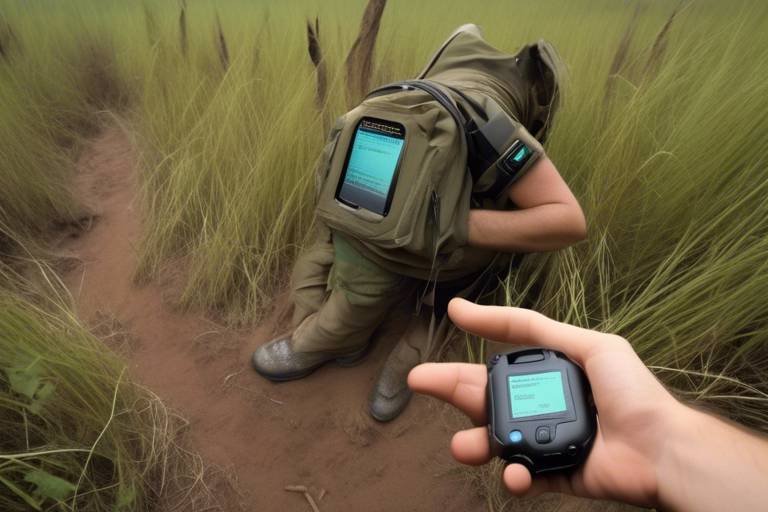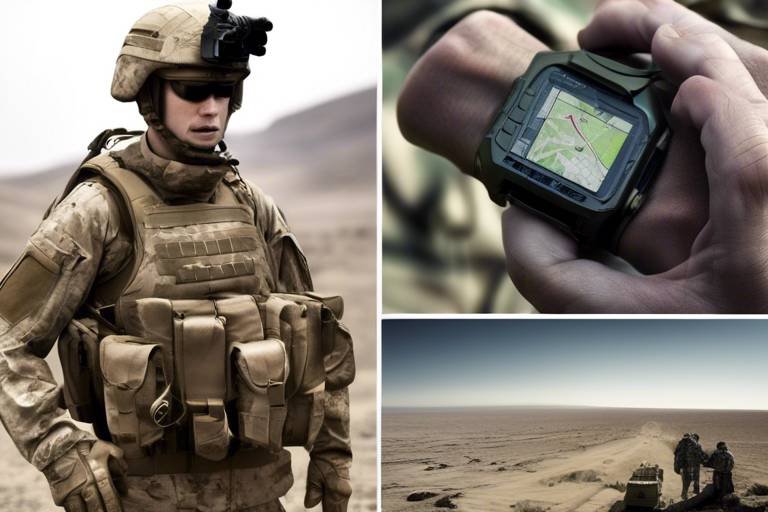The Use of Wearable Sensors in Wildlife Conservation Efforts
In today's rapidly changing world, the **importance of wildlife conservation** cannot be overstated. As habitats shrink and species face unprecedented threats, innovative solutions are essential for preserving biodiversity. One such solution that is making waves in the conservation community is the use of **wearable sensors**. These remarkable devices are not just gadgets; they represent a **revolution** in how researchers collect data and monitor wildlife. By providing real-time insights into animal behavior, health, and habitat use, wearable sensors empower scientists to make **informed decisions** that can significantly enhance conservation efforts.
Imagine being able to track the movements of a majestic elephant or monitor the health of a critically endangered bird without disturbing their natural habitat. Wearable sensors make this possible. They come in various forms, including GPS collars, accelerometers, and health monitors, each designed to gather specific data that can inform conservation strategies. For instance, GPS collars allow researchers to map migration patterns, while accelerometers can reveal changes in activity levels due to environmental stressors. This technology is not just about gathering data; it's about **understanding the intricate web of life** that exists within our ecosystems.
Moreover, the data collected from these sensors can lead to **better-informed policies** and conservation initiatives. With detailed insights into animal movements and interactions, conservationists can identify critical habitats that need protection or restoration. This proactive approach is essential in a world where species are disappearing at an alarming rate. By leveraging the power of wearable sensors, we are not only enhancing our understanding of wildlife but also taking **bold steps** towards ensuring their survival. The integration of this technology into conservation practices is a game-changer, offering a glimpse into a future where humans and wildlife can coexist more harmoniously.
Wearable sensors have emerged as a powerful tool in wildlife conservation, providing real-time data on animal behavior, health, and habitat use, allowing researchers to make informed decisions for species protection.
The integration of wearable sensors in wildlife studies offers numerous benefits, including improved tracking accuracy, reduced human intervention, and enhanced understanding of animal movements and interactions within their ecosystems. These benefits are crucial in a time when traditional methods of wildlife observation may not suffice. By utilizing technology, researchers can minimize their impact on the animals they study, ensuring that the data collected is as natural and unobtrusive as possible.
Various types of wearable sensors are utilized in wildlife conservation, including GPS collars, accelerometers, and heart rate monitors, each serving a unique purpose in monitoring animal behavior and health. The diversity of these tools allows researchers to tailor their approach based on the specific needs of the species they are studying.
GPS collars are widely used for tracking animal movements over large distances, allowing researchers to gather valuable data on migration patterns and habitat preferences. This information is vital for understanding how animals navigate their environments and the challenges they face. For example, tracking the migration routes of birds can reveal critical stopover sites that need protection to ensure their survival during long journeys.
Accelerometers provide insights into animal activity levels and behaviors, helping researchers understand how environmental changes affect species' daily routines and survival strategies. By analyzing the data from these sensors, researchers can detect shifts in behavior that may indicate stress due to habitat loss or climate change. This kind of information is essential for developing effective conservation strategies that address the root causes of these issues.
Wearable sensors also play a crucial role in monitoring the health of wildlife populations, enabling early detection of diseases and informing conservation strategies to mitigate threats. This proactive health monitoring can help prevent outbreaks that could devastate populations, allowing conservationists to implement measures before it's too late.
Despite their advantages, implementing wearable sensors in wildlife conservation comes with challenges, including technological limitations, data management issues, and the potential for human interference in natural behaviors. Addressing these challenges is crucial for maximizing the effectiveness of these tools.
The vast amounts of data collected by wearable sensors require sophisticated management systems to analyze and interpret, posing a challenge for researchers and conservationists alike. With data coming in from various sources, ensuring that it is processed efficiently and accurately is essential for drawing meaningful conclusions.
Ethical considerations surrounding the use of wearable sensors must be addressed, ensuring that animal welfare is prioritized and that the technology does not disrupt natural behaviors. It’s important to strike a balance between gathering valuable data and respecting the lives of the animals being studied.
The future of wearable sensors in wildlife conservation looks promising, with advancements in technology expected to enhance their effectiveness, leading to better-informed conservation strategies and improved outcomes for endangered species. As we continue to innovate and refine these tools, the potential for positive impact on wildlife conservation will only grow.
- What are wearable sensors? Wearable sensors are devices that can be attached to animals to monitor their behavior, health, and movement in real-time.
- How do wearable sensors help in wildlife conservation? They provide valuable data that can inform conservation strategies, track animal movements, and monitor health.
- What types of wearable sensors are commonly used? Common types include GPS collars, accelerometers, and heart rate monitors.
- Are there any ethical concerns with using wearable sensors? Yes, it's important to ensure that animal welfare is prioritized and that natural behaviors are not disrupted.
[Introduction to Wearable Sensors]
Wearable sensors have emerged as a powerful tool in wildlife conservation, fundamentally changing the way researchers collect data and monitor species. Imagine being able to track an animal's every move without disturbing its natural habitat. These innovative devices provide real-time data on animal behavior, health, and habitat use, allowing conservationists to make informed decisions that can significantly impact species protection. With the ability to gather extensive information, wearable sensors are like having a window into the lives of wildlife, revealing secrets that were previously hidden.
As technology advances, the application of these sensors is becoming increasingly sophisticated. For instance, researchers can now monitor how animals interact with their environment and each other. This not only enhances our understanding of specific species but also helps in assessing the overall health of ecosystems. The data gathered from these sensors can be compared to historical data, revealing trends and changes over time. Such insights are invaluable for developing effective conservation strategies.
Furthermore, wearable sensors are designed to minimize human intervention, which is crucial in wildlife studies. The less we interfere with an animal's natural behavior, the more accurate our data will be. This technology allows researchers to observe animals in their natural settings, providing a clearer picture of their daily lives. For example, when studying migratory patterns, wearable sensors can track the routes taken by animals, helping scientists to understand how climate change and habitat loss affect their journeys.
In summary, wearable sensors are revolutionizing wildlife conservation. They not only enhance data collection but also improve species monitoring, ultimately aiding in the preservation of biodiversity and ecosystems. The integration of these technologies into conservation efforts marks a significant step forward, ensuring that we are better equipped to protect our planet's precious wildlife.
[Benefits of Wearable Sensors]
Wearable sensors are transforming the landscape of wildlife conservation in ways that were previously unimaginable. Imagine being able to monitor the heartbeat of a majestic elephant or track the migratory patterns of a flock of birds without ever disturbing their natural habitat. This is not just a dream; it's a reality made possible by the integration of these advanced technologies into conservation efforts. The benefits of wearable sensors extend far beyond mere data collection; they fundamentally enhance our understanding of wildlife and their ecosystems.
One of the most significant advantages of wearable sensors is the improved tracking accuracy they offer. Traditional methods of tracking wildlife often involved human observers physically following animals, which could lead to stress and altered behaviors. In contrast, wearable sensors allow for real-time monitoring without direct human intervention. This means that researchers can gather crucial data on animal movements, social interactions, and habitat usage while minimizing their impact on the animals' natural behaviors.
Additionally, these sensors provide a wealth of information that can lead to an enhanced understanding of animal behaviors. For instance, by analyzing data collected from accelerometers, researchers can discern not only how much time animals spend moving but also the types of activities they engage in, such as foraging, resting, or socializing. This level of detail is critical for understanding how animals adapt to changes in their environment, whether it be through climate change, habitat destruction, or human encroachment.
Moreover, wearable sensors significantly reduce the need for human intervention in wildlife studies. This is crucial because excessive human presence can disrupt animal behavior and skew research results. By utilizing technology that can operate independently, conservationists can observe animals in their natural state, leading to more accurate and reliable data.
Another benefit worth mentioning is the ability of these sensors to monitor the health of wildlife populations. With the help of wearable technology, researchers can track vital signs and detect early signs of illness or distress in animals. This proactive approach enables conservationists to implement timely interventions, which can be the difference between life and death for endangered species. For example, if a sensor indicates that an animal's heart rate is abnormal, immediate action can be taken to investigate and address potential health issues.
In summary, the integration of wearable sensors in wildlife conservation is revolutionizing how we collect data and understand animal behaviors. The benefits include:
- Improved tracking accuracy: Real-time data without human interference.
- Enhanced understanding of behaviors: Detailed insights into activity levels and interactions.
- Reduced human intervention: Observing animals in their natural habitat.
- Health monitoring: Early detection of diseases and timely interventions.
By harnessing the power of technology, conservationists are better equipped to protect our planet's biodiversity and ensure that future generations inherit a world rich in wildlife. The journey is just beginning, and the potential for wearable sensors in wildlife conservation is truly exciting.
[Types of Wearable Sensors]
When it comes to wildlife conservation, the variety of wearable sensors available is as diverse as the species they monitor. Each type of sensor serves a unique purpose, contributing to a comprehensive understanding of animal behavior and health. Imagine having a toolkit filled with advanced gadgets that can tell you where an animal is, how it's feeling, and even what it's doing at any given moment. This is the magic of wearable sensors!
One of the most popular types of wearable sensors is the GPS collar. These collars are like high-tech necklaces for animals, allowing researchers to track their movements over vast distances. With GPS collars, scientists can gather crucial data on migration patterns, habitat preferences, and even social interactions among species. It's like having a front-row seat to nature's greatest performances, where each animal plays a vital role in the ecosystem.
In addition to GPS collars, another fascinating type of sensor is the accelerometer. Think of it as a fitness tracker for wildlife. Accelerometers measure how active an animal is, providing insights into their daily routines and behaviors. This information is invaluable for understanding how environmental changes, such as climate shifts or habitat loss, impact species survival. For instance, if an animal's activity levels drop, it may indicate stress or illness, prompting researchers to investigate further.
Furthermore, there are also heart rate monitors that can be integrated into wearable sensors. These monitors help scientists keep tabs on the health of wildlife populations by tracking their heart rates. Just like how a spike in our heart rate can signal stress or excitement, changes in an animal's heart rate can indicate health issues or emotional states. This real-time health monitoring can lead to early disease detection, allowing for timely interventions that can save lives.
To summarize, the types of wearable sensors used in wildlife conservation include:
- GPS Collars: For tracking movements and migration patterns.
- Accelerometers: For monitoring activity levels and behaviors.
- Heart Rate Monitors: For assessing health and emotional states.
Each of these sensors plays a crucial role in painting a complete picture of wildlife behavior, health, and interactions within their ecosystems. By harnessing the power of these advanced technologies, conservationists can make more informed decisions, ensuring that our planet's biodiversity is preserved for generations to come.
[GPS Collars]
GPS collars are revolutionizing the way researchers study wildlife, acting as a lifeline of information about animal movements and behaviors. Imagine being able to follow an animal's journey across vast landscapes without ever having to be physically present. That's the magic of GPS technology! These collars are not just pieces of equipment; they are sophisticated devices that harness the power of satellite signals to provide real-time tracking data. This means that researchers can monitor migration patterns, habitat preferences, and even social interactions among species with unprecedented accuracy.
One of the most significant advantages of GPS collars is their ability to cover large distances. For instance, when studying migratory birds or large mammals like elephants, researchers can gain insights into their seasonal movements and the routes they take. This data is crucial for understanding how animals adapt to environmental changes, such as climate shifts or habitat loss. By analyzing the information collected from GPS collars, conservationists can identify critical habitats that need protection and develop strategies to mitigate the impact of human activities.
Furthermore, GPS collars can be equipped with additional sensors, such as accelerometers and temperature gauges, which provide even more detailed information about an animal's behavior and health. This multi-faceted approach allows researchers to not only track where animals go but also how they interact with their environment. For example, by monitoring the activity levels of a predator and its prey, scientists can gain insights into the dynamics of the ecosystem and how various species depend on one another for survival.
However, while GPS collars offer incredible benefits, they are not without challenges. The collars must be designed to be lightweight and comfortable for the animals, ensuring that they do not interfere with natural behaviors. Additionally, researchers must navigate the complexities of data management, as the sheer volume of information generated can be overwhelming. Nevertheless, the potential for these devices to enhance our understanding of wildlife is immense, making them an invaluable tool in the quest for conservation.
- How do GPS collars work? GPS collars use satellite signals to track the location of animals in real-time, allowing researchers to gather data on their movements and behaviors.
- Are GPS collars safe for animals? Yes, when designed properly, GPS collars are lightweight and comfortable, ensuring minimal disruption to the animal's natural behavior.
- What kind of data can be collected with GPS collars? GPS collars can provide data on migration patterns, habitat use, activity levels, and even health indicators when equipped with additional sensors.
- How does this technology help with conservation efforts? By providing critical data on wildlife movements and behaviors, GPS collars help conservationists make informed decisions to protect endangered species and their habitats.
[Accelerometers]
When we think about tracking wildlife, we often picture GPS collars and satellite images. However, accelerometers are becoming the unsung heroes of wildlife conservation. These nifty devices, which measure the acceleration of an animal's movements, provide researchers with invaluable insights into how animals interact with their environment. Imagine trying to understand the daily life of a deer without knowing how much it runs, jumps, or even rests. That’s where accelerometers come into play!
Accelerometers can detect changes in speed and direction, allowing scientists to interpret an animal's behavior in real-time. For instance, if a bear is frequently climbing trees, the data from the accelerometer can reveal not just the frequency of these activities but also their duration and intensity. This information is crucial for understanding how environmental factors, such as food availability or habitat disturbances, impact animal behavior.
Additionally, the data collected by accelerometers can be used to identify patterns in animal activity, such as foraging habits, mating behaviors, and even predator avoidance strategies. By analyzing this data, conservationists can make informed decisions about habitat protection and management strategies. For example, if a specific area is identified as a frequent foraging ground for a vulnerable species, conservation efforts can be concentrated there to ensure that the habitat remains intact.
To illustrate the power of accelerometers in wildlife research, consider the following table that summarizes key insights derived from their use:
| Animal Species | Behavior Monitored | Insights Gained |
|---|---|---|
| Red Fox | Hunting and Foraging | Identified peak activity times and preferred hunting grounds. |
| Elephant | Migration Patterns | Revealed critical corridors for seasonal movement. |
| Hummingbird | Feeding Behavior | Documented nectar consumption rates and flower preferences. |
In essence, accelerometers are like a fitness tracker for wildlife, providing a detailed account of an animal's physical activities. This level of detail is essential for conservationists aiming to protect species in a rapidly changing world. As we continue to develop and refine these technologies, the potential for understanding and preserving wildlife becomes even greater. Who knows? The next breakthrough in conservation might just come from the data collected by an accelerometer strapped to a wandering wolf!
- What are accelerometers?
Accelerometers are devices that measure the acceleration of movements, allowing researchers to monitor animal behaviors in real-time. - How do accelerometers help in wildlife conservation?
They provide insights into animal activity levels, behaviors, and interactions with their environment, which are crucial for effective conservation strategies. - Can accelerometers track all animal species?
While they can be used on many species, the size and behavior of the animal can determine the type of accelerometer used.
[Health Monitoring with Sensors]
Wearable sensors are not just about tracking movements; they are pivotal in health monitoring of wildlife populations. Imagine having a window into the health status of animals in their natural habitats. This technology allows researchers to detect potential health issues before they escalate into significant threats. For instance, sensors can monitor physiological indicators such as heart rate, body temperature, and even stress levels. By analyzing these metrics, scientists can identify abnormalities that might suggest illness or distress, enabling timely interventions.
One of the most significant advantages of wearable sensors is their ability to facilitate early disease detection. In wildlife, diseases can spread rapidly, often with devastating effects on populations. By employing sensors, researchers can track health trends over time, identifying patterns that may indicate an outbreak. For example, if a group of animals shows a sudden spike in heart rates or a drop in activity levels, it could signal the onset of a disease, prompting immediate investigation and action.
Moreover, these sensors can help in monitoring the effects of environmental changes on animal health. As habitats shift due to climate change or human encroachment, animals may experience stress that impacts their well-being. Through continuous health monitoring, researchers can gather data that correlates environmental factors with health outcomes. This information is invaluable for developing conservation strategies that not only protect wildlife but also enhance their resilience to changing conditions.
The integration of wearable sensors into health monitoring programs also fosters a more holistic understanding of wildlife health. By combining data from various sensors, researchers can create comprehensive health profiles for different species. This data can be analyzed to reveal insights into how social dynamics, reproductive success, and habitat quality influence overall health. The result? More informed conservation decisions that take into account the complex interplay of factors affecting wildlife.
In summary, wearable sensors are revolutionizing health monitoring in wildlife conservation. They provide critical insights that help in early disease detection, understanding the impact of environmental changes, and developing comprehensive health profiles for species. As technology continues to advance, the potential for these sensors to contribute to the preservation of biodiversity becomes even more promising. The future of wildlife conservation is not just about protecting habitats but also ensuring the health and well-being of the animals that inhabit them.
- What types of data can wearable sensors collect? Wearable sensors can collect a variety of data, including heart rate, body temperature, movement patterns, and stress levels.
- How do researchers use this data? Researchers analyze the data to monitor animal health, detect diseases early, and understand how environmental changes affect wildlife.
- Are there any ethical concerns with using wearable sensors? Yes, ethical considerations include ensuring animal welfare and minimizing disruption to natural behaviors.
- What are some challenges in implementing wearable sensors? Challenges include technological limitations, data management issues, and the potential for human interference.
[Challenges of Implementing Sensors]
While the integration of wearable sensors in wildlife conservation has opened up a world of possibilities, it is not without its challenges. One of the primary hurdles is the technological limitations that come with deploying these devices in the wild. Many sensors require a stable power source and reliable connectivity, which can be difficult to achieve in remote locations. Imagine trying to keep your smartphone charged while hiking through dense forests or across vast savannas; wildlife faces similar obstacles. If the technology fails, researchers lose valuable data that could inform critical conservation efforts.
Another significant challenge is data management. The sheer volume of information generated by these sensors is staggering. For instance, a single GPS collar can produce thousands of data points each day, tracking an animal’s every move. This data must be processed, analyzed, and interpreted, which requires sophisticated software and skilled personnel. Without proper management, it can be like trying to find a needle in a haystack—overwhelming and often unmanageable. Researchers must find ways to streamline data collection and analysis to ensure they can act swiftly on the insights gained.
Moreover, there is the risk of human interference in natural behaviors. When animals are equipped with wearable sensors, their movements might be altered by the presence of humans or the technology itself. For example, if an animal senses that it is being tracked, it may change its behavior to avoid detection, thus skewing the data collected. This phenomenon raises important ethical questions: how do we balance the need for data with the well-being of the animals we aim to protect?
In addition to these challenges, researchers must also consider the financial implications of implementing wearable sensors. The costs associated with developing, deploying, and maintaining these technologies can be significant. Funding for conservation projects is often limited, and allocating resources to advanced technologies may divert funds from other critical areas, such as habitat restoration or community engagement. This creates a delicate balancing act for conservationists who must prioritize where their efforts will have the most impact.
Finally, there are ethical considerations surrounding the use of wearable sensors. It’s crucial to ensure that the welfare of the animals is prioritized. Researchers must adhere to strict guidelines to minimize stress and discomfort for the wildlife they study. This includes ensuring that sensors are lightweight, non-invasive, and do not hinder the animals’ natural behaviors. The goal is to gather data without compromising the integrity of the species or their ecosystems.
In conclusion, while wearable sensors are revolutionizing wildlife conservation, the challenges of technology, data management, human interference, financial constraints, and ethical considerations must be addressed. By overcoming these obstacles, we can harness the full potential of this innovative technology to protect biodiversity and promote healthier ecosystems.
- What are wearable sensors? Wearable sensors are devices that can be attached to wildlife to monitor their behavior, health, and movements in real-time.
- How do wearable sensors help in wildlife conservation? They provide valuable data that helps researchers understand animal behaviors, track migration patterns, and monitor health, which can inform conservation strategies.
- What challenges are associated with using wearable sensors? Challenges include technological limitations, data management issues, human interference, financial constraints, and ethical considerations regarding animal welfare.
- Are there ethical concerns with using wearable sensors on animals? Yes, researchers must ensure that the use of sensors does not cause undue stress or alter natural behaviors in wildlife.
[Data Management Issues]
As the use of wearable sensors in wildlife conservation grows, so do the challenges associated with managing the colossal amounts of data they generate. Imagine trying to find a needle in a haystack, but instead of a needle, you're sifting through terabytes of data collected from numerous animals across vast landscapes. This is the reality for researchers and conservationists today. The data collected from these sensors can include everything from GPS coordinates to heart rates, and while this information is invaluable, it also requires sophisticated systems for effective analysis.
One significant issue is the sheer volume of data produced. With thousands of sensors deployed, each generating continuous streams of data, the task of storing and processing this information becomes daunting. Researchers often find themselves overwhelmed, struggling to keep up with the influx of data while ensuring that they can extract meaningful insights from it. To illustrate this point, consider the following table that outlines the average data generated by different types of wearable sensors:
| Type of Sensor | Data Generated per Day (GB) |
|---|---|
| GPS Collars | 1-5 |
| Accelerometers | 0.5-2 |
| Heart Rate Monitors | 0.2-1 |
In addition to storage concerns, analyzing this data requires advanced software and skilled personnel. Many conservation teams may not have access to the latest technology or the expertise needed to interpret complex datasets. This gap can lead to delays in decision-making, which is critical in conservation efforts where timely actions can mean the difference between survival and extinction for endangered species.
Moreover, the integration of data from various sensors poses another layer of complexity. Each sensor type collects different kinds of information, and combining these datasets into a cohesive analysis can be challenging. Researchers must ensure that the data is compatible and can be accurately interpreted together, which often requires custom software solutions and extensive testing.
Lastly, there’s the issue of data privacy and security. As more data is collected, the risk of it being misused or accessed by unauthorized parties increases. Conservationists must navigate the ethical implications of data management, ensuring that sensitive information about wildlife populations is kept secure while still being accessible for research purposes.
In conclusion, while wearable sensors are revolutionizing wildlife conservation, the data management issues they bring cannot be overlooked. Addressing these challenges is crucial for maximizing the potential of this technology and ensuring that it contributes effectively to the preservation of our planet's biodiversity.
- What are wearable sensors? Wearable sensors are devices attached to animals that collect data on their movements, health, and behaviors in real-time.
- How do wearable sensors benefit wildlife conservation? They provide valuable insights into animal behavior and health, allowing for better-informed conservation strategies.
- What are the challenges of using wearable sensors? Data management, technological limitations, and ethical considerations are some of the main challenges faced.
- Can the data from wearable sensors be misused? Yes, there is a risk of data being accessed by unauthorized parties, highlighting the need for secure data management practices.
[Ethical Considerations]
When it comes to the use of wearable sensors in wildlife conservation, ethical considerations are paramount. While these technologies offer groundbreaking insights into animal behavior and health, we must tread carefully to ensure that we are not compromising the welfare of the very creatures we aim to protect. Imagine strapping a device onto an animal that could potentially alter its natural behavior—this is a significant concern for conservationists.
One of the primary ethical dilemmas revolves around the impact on animal welfare. The introduction of wearable sensors can cause stress or discomfort to wildlife. For instance, if a GPS collar is too tight or heavy, it may hinder the animal's movement or even lead to injury. Therefore, it is crucial for researchers to prioritize the comfort and safety of the animals while deploying these devices. This involves careful selection of materials and sizes, as well as thorough testing before actual field deployment.
Moreover, there is the question of informed consent, albeit in a non-human context. While we cannot ask animals for their permission, conservationists must consider whether the benefits of monitoring outweigh the potential risks involved. This leads us to the importance of minimizing human interference in natural behaviors. The ultimate goal is to gather data that reflects true animal behavior in their natural habitats, but excessive monitoring can skew these findings.
Another ethical consideration is the potential for misuse of data. The information collected from wearable sensors can be incredibly powerful, but it also raises concerns about privacy and the potential for exploitation. For example, if data about endangered species' locations falls into the wrong hands, it could lead to poaching or habitat destruction. Thus, researchers and conservationists must establish stringent data management protocols to protect sensitive information.
To address these ethical issues, many organizations are developing guidelines and best practices for the use of wearable sensors in wildlife studies. These guidelines often include:
- Conducting thorough impact assessments before deploying sensors.
- Ensuring that devices are lightweight and non-intrusive.
- Implementing strict data protection measures to safeguard sensitive information.
- Engaging with local communities and stakeholders to foster transparency and accountability.
In conclusion, while wearable sensors hold immense potential for wildlife conservation, it is essential to approach their implementation with a strong ethical framework. By prioritizing animal welfare, minimizing human interference, and safeguarding data, we can harness the power of technology to protect biodiversity without compromising the integrity of the ecosystems we study.
- What are wearable sensors? Wearable sensors are devices attached to animals to monitor their behavior, health, and movements in real time.
- How do wearable sensors help in wildlife conservation? They provide valuable data that helps researchers understand animal behavior and health, enabling better conservation strategies.
- Are there any risks associated with using wearable sensors? Yes, risks include potential stress or harm to the animal and the misuse of collected data.
- What measures are taken to ensure animal welfare? Researchers conduct impact assessments and use lightweight, non-intrusive devices to minimize discomfort.
- How is the data from wearable sensors protected? Stringent data management protocols are established to safeguard sensitive information from misuse.
[Future of Wearable Sensors in Conservation]
The future of wearable sensors in wildlife conservation is not just bright; it’s practically glowing with potential! As technology advances at an unprecedented pace, the capabilities of these sensors are expected to evolve, leading to more effective conservation strategies. Imagine a world where researchers can monitor the health and behavior of endangered species in real-time, all while minimizing human interference in their natural habitats. This is not just a dream; it's becoming a reality!
One of the most exciting prospects is the integration of artificial intelligence (AI) with wearable sensors. AI can analyze vast amounts of data collected from these devices, identifying patterns and trends that would be nearly impossible for humans to discern. For instance, AI algorithms could automatically flag changes in an animal's behavior or health, alerting conservationists to potential issues before they escalate. This proactive approach could significantly enhance the survival rates of vulnerable species.
Moreover, advancements in biotechnology are paving the way for sensors that can monitor not just location and movement but also physiological parameters such as stress levels, hydration, and even reproductive health. This multi-faceted data collection will provide a comprehensive view of an animal's well-being, allowing conservationists to tailor their strategies to meet the specific needs of different species.
As we look ahead, the collaboration between tech companies, universities, and conservation organizations will be crucial. By pooling resources and expertise, these groups can develop innovative solutions that address the unique challenges faced by wildlife conservation. For instance, the creation of low-cost, durable sensors that can withstand harsh environments will be essential for long-term studies in remote areas.
To illustrate the potential of these collaborations, consider the following table showcasing some emerging technologies in wearable sensors:
| Technology | Description | Potential Impact on Conservation |
|---|---|---|
| Smart Collars | Collars equipped with GPS, accelerometers, and health monitors | Real-time tracking and health monitoring of wildlife |
| Bio-sensors | Sensors that monitor physiological parameters | Early detection of health issues in populations |
| Drone Technology | Drones equipped with cameras and sensors | Monitoring hard-to-reach areas and tracking large groups |
As we embrace these innovations, we must also keep in mind the ethical implications of using wearable sensors. Ensuring that these devices do not disrupt natural behaviors or cause undue stress to animals is paramount. The key is to strike a balance between technological advancement and ethical responsibility.
In conclusion, the future of wearable sensors in wildlife conservation is not just about technology; it’s about creating a sustainable future for our planet's biodiversity. With continuous advancements and a commitment to ethical practices, we can look forward to a future where conservation efforts are more effective, informed, and compassionate than ever before.
- What are wearable sensors? Wearable sensors are devices that can be attached to animals to monitor their movements, health, and behavior in real-time.
- How do wearable sensors help in wildlife conservation? They provide valuable data that helps researchers understand animal behavior, health, and habitat use, leading to better conservation strategies.
- Are there any ethical concerns with using wearable sensors? Yes, it is important to ensure that these devices do not disrupt natural behaviors or cause stress to the animals.
- What technologies are being integrated with wearable sensors? Technologies like artificial intelligence and biotechnology are being integrated to enhance the capabilities of wearable sensors.
Frequently Asked Questions
- What are wearable sensors in wildlife conservation?
Wearable sensors are advanced devices that animals can wear, such as GPS collars and accelerometers. They collect real-time data on various aspects of wildlife, including behavior, health, and habitat use, which helps researchers make informed decisions for conservation efforts.
- How do wearable sensors benefit wildlife conservation?
These sensors improve tracking accuracy, reduce the need for human intervention, and enhance our understanding of animal movements and interactions. This data is crucial for developing effective conservation strategies to protect endangered species and preserve ecosystems.
- What types of wearable sensors are commonly used?
Common types include GPS collars for tracking movements, accelerometers for monitoring activity levels, and heart rate monitors for assessing health. Each type serves a unique purpose in understanding wildlife behavior and well-being.
- Can wearable sensors help in health monitoring of wildlife?
Absolutely! Wearable sensors play a critical role in monitoring wildlife health by enabling early detection of diseases. This information is vital for implementing timely conservation strategies to mitigate potential threats to animal populations.
- What challenges are associated with implementing wearable sensors?
Challenges include technological limitations, the vast amounts of data that require sophisticated management systems, and ethical concerns regarding animal welfare. It's essential to ensure that these technologies do not disrupt natural behaviors or harm the animals.
- What are the ethical considerations when using wearable sensors?
Ethical considerations revolve around prioritizing animal welfare and ensuring that the use of technology does not interfere with the natural behaviors of wildlife. Researchers must be cautious and respectful in their approach to using these devices.
- What does the future hold for wearable sensors in conservation?
The future looks bright! Advancements in technology are expected to enhance the effectiveness of wearable sensors, leading to better-informed conservation strategies and improved outcomes for endangered species. It's an exciting time for wildlife conservation!



















